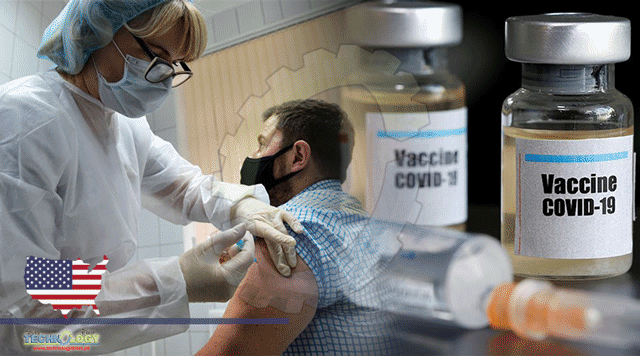In The U.S., Vaccine Rollout Has Been Plagued With Logistical Issues As States Have Been Left To Create Their Own Distribution Plans.

As we enter the second year of the pandemic, all eyes are on the COVID-19 vaccination effort. In The U.S., The Vaccine Rollout Has Been Plagued With Logistical Issues As States Have Been Left To Create Their Own Distribution Plans Without Adequate Resources. Despite former President Donald Trump’s promise to vaccinate 20 million people by the end of 2020, only about 2.8 million Americans received the vaccine before the turn of the year.
Upon taking office, President Joe Biden announced his goal to vaccinate 100 million people within his first 100 days of office, and last week, the U.S. government secured another 200 million doses to be delivered by the end of July. In discussions of U.S. vaccine rollout, scarcity has been the major theme: There aren’t enough vaccines to meet demand, and people who need them most—health care workers, people of color, front-line workers, those over 65—can’t get access. But compared with much of the world, the U.S. is doing quite well.
We’ve administered the most doses of any country, and are fifth when it comes to doses per capita. Meanwhile, many countries haven’t even begun their vaccinations, and the U.S. is making it harder for them. That additional 200 million doses the U.S. secured brings the country’s reserved vaccine dose count to 1.2 billion doses, according to data compiled by the Duke Global Health Innovation Center’s Launch and Scale Speedometer. There are currently 60 countries and multinational coalitions with confirmed reservations for vaccine doses; the U.S.’s share is greater than the combined reservation of 45 of those entities. For comparison’s sake, Pakistan’s population is roughly 68 percent of the U.S.’s, but its vaccine reservation is 17.5 percent of the U.S.’s.
“The [vaccine] scene globally is one of inequity, which is what we’ve been worried about for some time now,” says Krishna Udayakumar, founding director of Duke Global Health Innovation Center. When it comes to vaccine doses, it seems rich countries are only getting richer, squashing opportunities for less wealthy countries to access the vaccine. According to the Economist Intelligence Unit, some countries may not see a significant portion of their population vaccinated until 2024.
Like Udayakumar alluded to, global health experts have been anticipating this possibility since the beginning of the pandemic. In June, the World Health Organization, along with partners the Coalition for Epidemic Preparedness Innovations and Gavi, the Vaccine Alliance, released a plan called COVAX to pool nations’ resources for developing and purchasing COVID-19 vaccines.
At the time, investing in vaccine development was a risky proposition; it was a gamble whether any of the more than 100 vaccines in development would be safe, effective, and make it to market. COVAX allowed countries to pool resources and buy into a “portfolio approach”—their contribution bought into a pool of vaccine investments. “You could aggregate demand and use market power to get better prices for vaccines,” says Udayakumar. Once a vaccine was available, doses would be distributed to all participating countries at the same rate, based on their total population, according to a Gavi explainer written in September.
But as soon as promising vaccine trial results were released, rich countries directed their resources away from COVAX and toward pharmaceutical companies directly. “Rather than COVAX being the major platform purchasing vaccines, what we saw instead was that most countries in the world decided to go out and buy or reserve vaccine doses on their own bilateral deals,” says Udayakumar. Wealthier countries had the political and financial power to negotiate deals directly with Pfizer, Moderna, and AstraZeneca, often issuing emergency use orders that expedited the procurement process.
Of the 8.2 billion confirmed vaccine doses purchased so far, more than 7 billion have come directly from such deals, with just 1.1 billion through COVAX. “There’s only so much capacity in the world to produce those vaccines, and that capacity was tied up by a few rich countries; there was nothing left over for the rest,” says Leena Menghaney, global intellectual property adviser for the Médecins Sans Frontières Access Campaign. To Menghaney’s point, the U.S. has individually secured more doses than COVAX. Our supply is nearly enough to vaccinate the entire U.S. population at least twice over and constitutes nearly 15 percent of the world’s total confirmed purchases.
These bilateral deals not only decrease immediate access to vaccine doses but also weaken COVAX’s negotiating and buying power. “Acquisition through bilateral agreements is to the exclusion of others,” says Safura Abdool Karim, a public health lawyer in South Africa and member of the African CDC’s African Vaccine Delivery Alliance. Pharmaceutical companies know they can strike big deals with wealthy countries directly, so they have little incentive to make deals with COVAX.
As a result, vaccine doses are now concentrated primarily in North America and Europe. “By the middle of this year, you’ll have high-income countries vaccinating 30 to 40, even half of their population, while developing countries will still not barely reach 3 percent of the population,” says Menghaney. On Friday, the U.S. pledged to donate $4 billion to COVAX and encouraged other wealthy nations to do the same, but this came only after the country had already secured its own direct deals with companies.
This news was originally published at Slate.